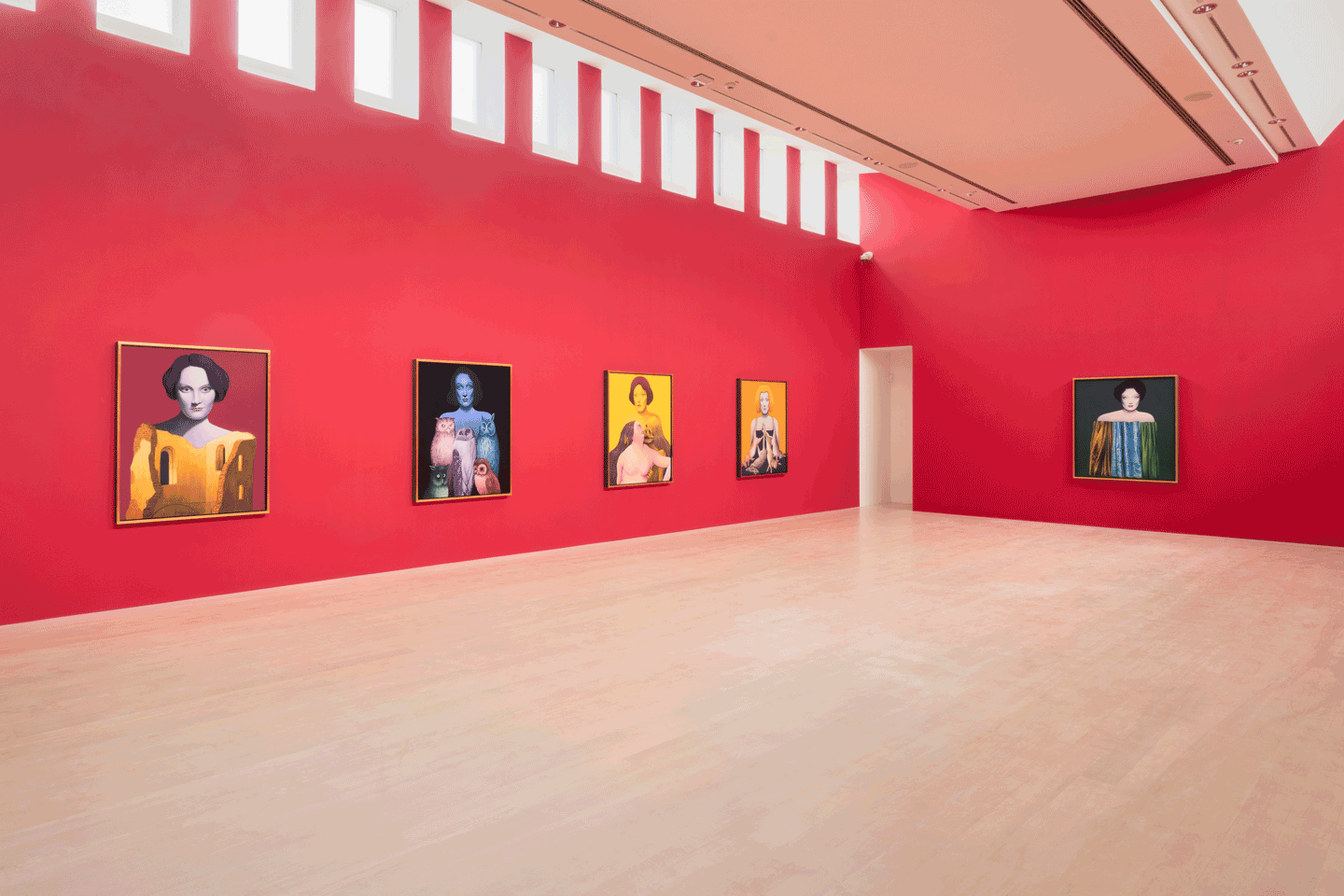Stage Fright
September 12, 2021–January 9, 2022
Goseriede 11
30159 Hanover
Germany
Hours: Tuesday–Sunday 11am–6pm,
Thursday 11am–8pm
The Kestner Gesellschaft is proud to present the exhibition Stage Fright by Nicolas Party (b. 1980 in Lausanne, Switzerland) with brand new works: With his immersive mural Grotto the artist transforms the large exhibition hall into a spectacular green cave. The work becomes a breathtaking and atmospheric spatial experience for visitors. In addition, a new series of nine portraits starring Marlene Dietrich is presented for the first time. Party combines her portrait with iconic paintings of art history, for example in Portrait with Iceberg he appropriates details from the famous painting The Sea of Ice (1823) by Caspar David Friedrich. The Kestner Gesellschaft looks at Nicolas Party’s work through a cinematic lens: The title of the exhibition Stage Fright can be read as a reference to a stage production as well as to Marlene Dietrich herself, who played the lead role in Alfred Hitchcock’s film noir of the same title from 1950.
The Grotto
Nicolas Party has created a site-specific mural especially for the exhibition at the Kestner Gesellschaft: a grotto that extends over the walls and ceiling of the skylight hall and transforms the room into a cave full of green leaves. The starting point of Nicolas Party’s artistic approach is his engagement with the history and architecture of an exhibition space. The specific history and architecture of the Kestner Gesellschaft as a public swimming pool in the Art Nouveau style inspired Party to create this mural in the domed hall, which can also be viewed as an alternative to the traditional, neutral white cube.
Nicolas Party’s interest in caves is evident in his interview with the French art critic Eric Troncy: “I think caves lead to something darker and more foreign inside. What interests me about the subject is that it is a historical imprint, a broadly anchored place in the history of representation. You can find an incredible amount of symbolism and history in it.”
These art historical references are typical in the work of Nicolas Party: from Giotto’s (1267–1337) Frescoes in Assisi to Gustave Courbet’s (1819–1877) The Source of the Loue (1864) to The Grotto of Manacor (ca. 1901) by the Belgian painter William Degouve de Nuncques (1867–1935), depictions of underground caves conjure up a wealth of historical and philosophical connotations. Nicolas Party translates this motif into a holistic spatial concept that was specially developed for the Kestner Gesellschaft. Nicolas Party’s immersive mural refers to these art-historical predecessors that depict underground caves. At the same time, it becomes a breathtaking and atmospheric spatial experience for visitors.
Places of joy and wonder, lush products of ingenuity and craftsmanship, shaped by artists and architects—artificial caves have always attracted people. While they originated in the Hellenistic and Roman world in the first century BC, the appreciation for these picturesque and fantastical places developed in Renaissance culture between the 15th and 16th centuries, particularly in the Mannerist and Baroque periods up to the 17th century, and the more romantic conceptions of the 19th and 20th centuries. Caves have taken on different symbolic meanings: As symbols of the landscape of the Great Goddess, in which human beings are part of nature, as in Homer’s Odyssey and Ovid’s Metamorphoses, in the humanistic Renaissance caves were reinterpreted as places of transformation which evoke mythological associations that are part of ancient and Christian tradition. In Romanticism, caves came to symbolize mysterious and terrible places, the scene of a hidden life, beyond human influence. Over the years, the cave became a theater of Dionysian passions that fascinated both decadent poets and symbolist artists of the late 19th century, as well as the Italian Futurists, who organized their exhibitions and avant-garde cabarets in Rome in the 1920s, which took place in underground rooms of ancient Roman monuments—the “Grotte dell’Augusteo.”
Marlene
Nicolas Party’s portraits also show clear references to the history of painting. For example, his latest work Portrait with Curtains (2021) is reminiscent of Surrealist paintings by René Magritte, which often include curtains. Party completely dispenses with personality traits, which gives the figures a strangely detached and mask-like appearance. He also leaves the current question of gender categories unanswered. Nicolas Party belongs to a new generation of painters who use the traditional medium of painting to approach current issues of representation. The artist does not focus on a specific individual in his portraits, but rather on the representation of people in painting. His most recent portraits include the characteristic face of Marlene Dietrich. Here, too, Party reduces the person to basic elements in order to test the limits of what is still recognizable as “Marlene.” In the 1930s, the actress corresponded to the type of a garçonne, the androgynous female type of the time, and was one of its most famous examples. The artist thus explores the spaces between person and representation, reality and fiction, and fundamentally questions the claim to depict reality.


